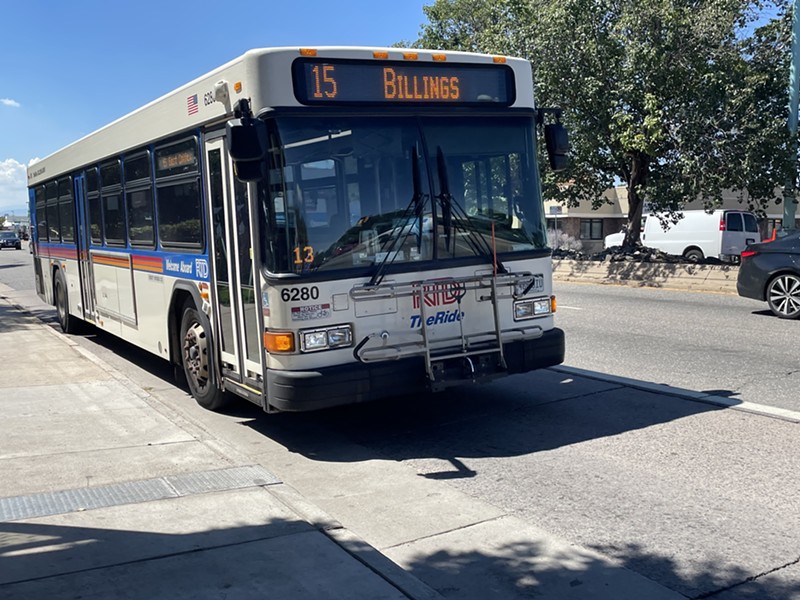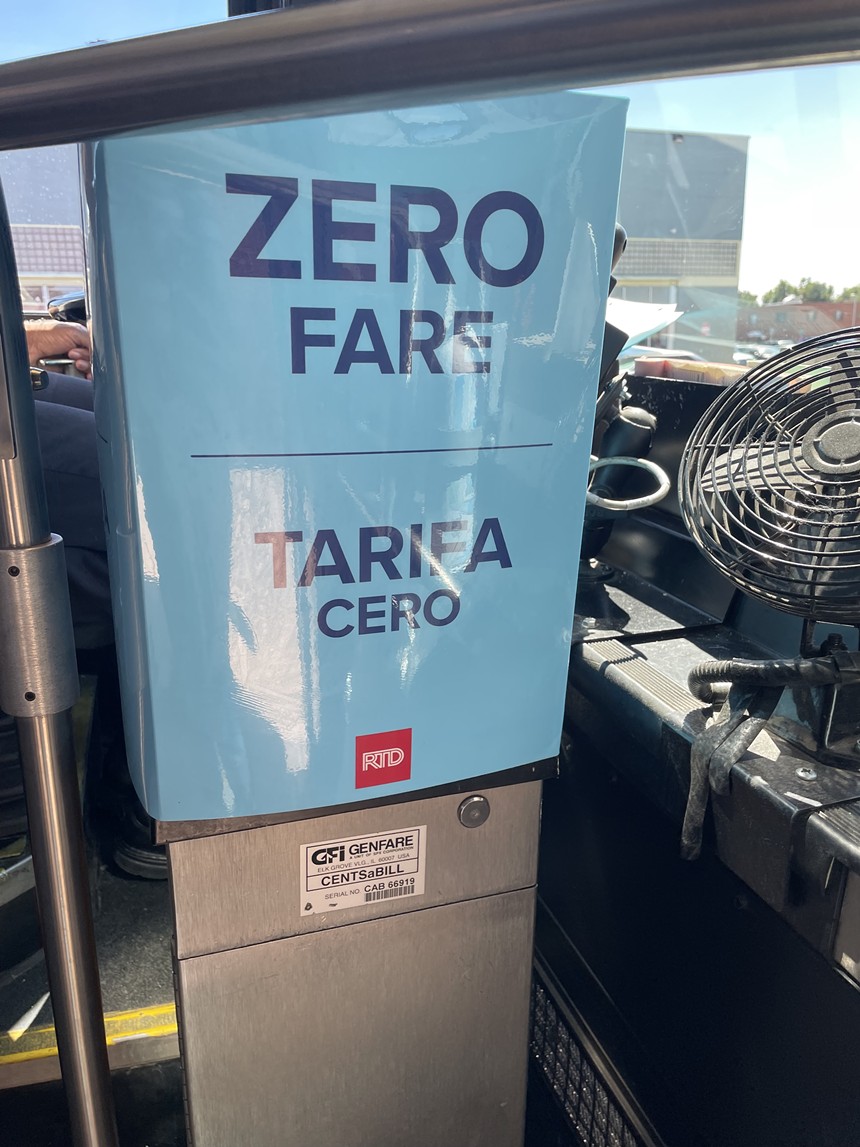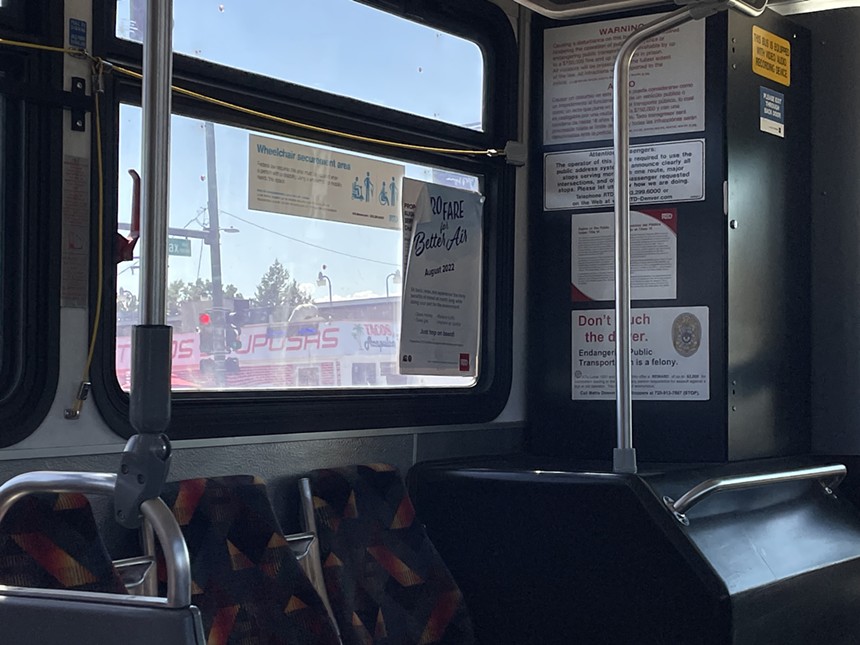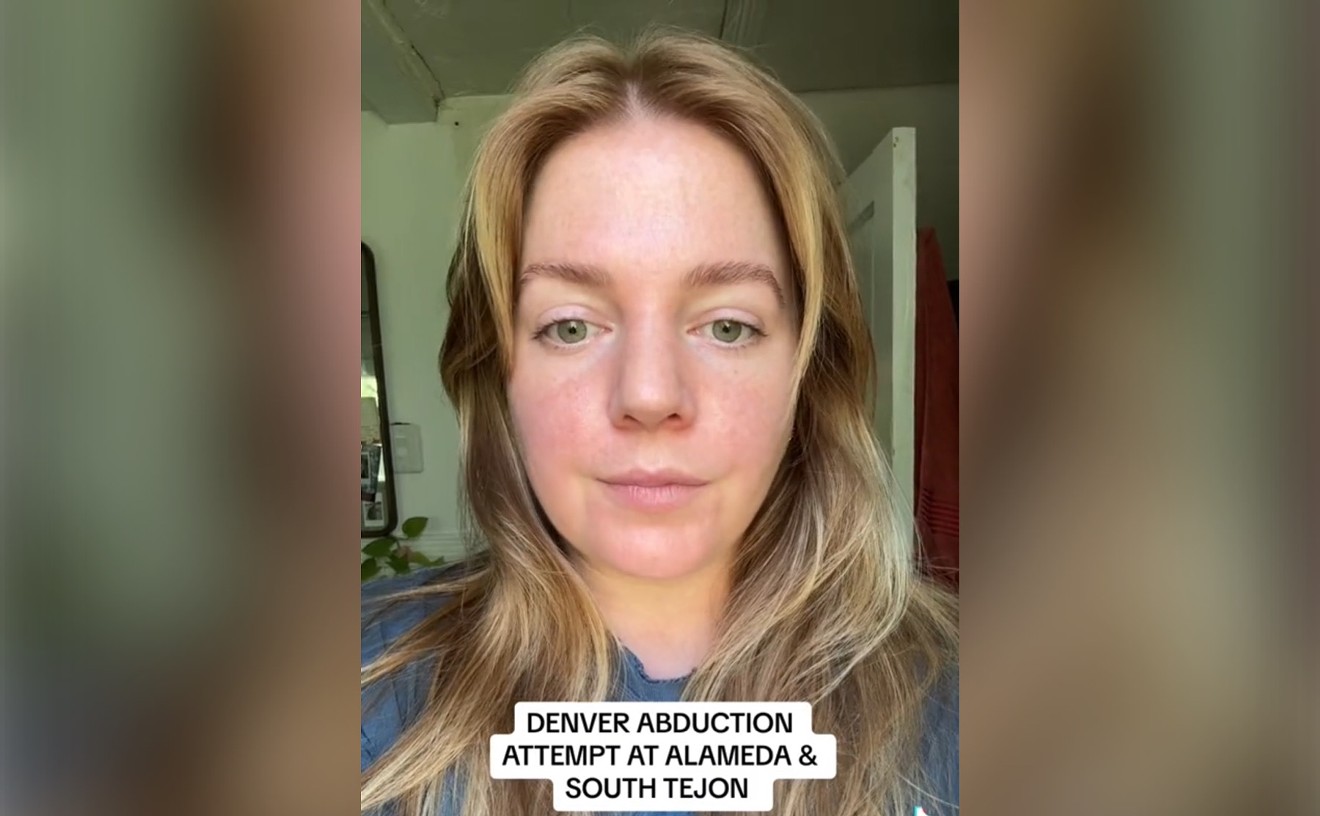I’ve always loved riding the bus, and regularly took RTD's 52 line from Regis University to downtown Denver for internships, Rockies games and bar crawls when I was in college. I never felt unsafe, and once when I fell asleep on my way to work after staying too late at a Fourth of July party, a fellow commuter who knew my stop woke me and made sure I didn't miss it.
But that was all before the pandemic, when I headed to graduate school in Phoenix (where I rode the bus to Arizona State University's downtown campus most days). And once back in Denver, I moved into a place within walking distance of my job; as a result, I'd only been on an RTD bus once since COVID hit. But when RTD rolled out its Zero Fare for Better Air initiative, part of a Colorado Legislature-backed program to offer free public transit rides in August in an attempt to decrease ozone, I decided it was time to get back on board.
And the obvious route to ride was the 15, the focus of a June Washington Post story by reporter Eli Saslow titled “Anger and heartbreak on Bus No. 15,” which described how the pandemic was impacting bus drivers across the country — particularly in Denver.
It focused on Suna Karabay, who drives the 15 bus on Colfax Avenue for RTD, and what Saslow observed while riding along with Karabay, from her love for the city and sadness at its changes to the difficulties faced by the bus drivers. The end of the piece recounted how, after being harassed by a particularly angry passenger who'd only paid half of his bus fare, Karabay stopped working for the day, leaving her route before her shift officially ended.
Karabay, whose face is featured on the side of some buses, wasn't driving the 15 bus when I spent a Wednesday afternoon riding along Colfax, all the way to Havana Street and back. (Saslow had made two trips to Denver, riding along with Karabay for several days each time.) And my day was relatively drama-free, though a fellow who boarded at Clarkson Street with me got it off to an exciting start.
He got agitated and started yelling at other people getting on the bus. “Welcome to Colorado,” he shouted. “Can you believe the country these days?”
The passenger behind him finally tapped the man on the shoulder. At first the agitated man reacted badly, telling that person never to touch him again, but the passenger persisted, encouraging him to breathe and take a walk. The two of them then fist-bumped and got off at the next stop, pausing to thank the driver on their way out.
According to RTD, it won’t have data on ridership and any other incidents during free-fare month until November, when it will present a report to its board of directors. “We also will be working to gain an understanding of this period through customer and RTD employee surveys, providing feedback from external and internal sources,” the district says. “This information will be included in a final report that will be submitted to the Colorado Energy Office, a requirement of the grant that is funding the replacement fare revenue and other expenses.”
Saslow says that he decided to do his bus story after noticing that crime on public transportation was increasing around the country. He researched several cities before eventually picking Denver. “The truth is, every big city…they're all experiencing versions of the same problem,” he says. “Denver is struggling in this moment with the opioid epidemic, rising homelessness, rising crime stats.”
In his story, Saslow noted that homelessness in the city was up by 50 percent since before the pandemic, that violent crime had increased by 17 percent, and that “seizures of fentanyl and methamphetamine had quadrupled in the past year.”
As he researched which route to take, people kept bringing up the 15 or 15L. Then he looked for the right driver, speaking to about ten before deciding on Karabay. “She talked really movingly about the way she was just beat down,” Saslow says. “The fact that her face is on the side of some of these buses, and she just felt like she was sort of losing her love for the city in some ways.”
He could tell she would stand up for herself one day, he recalls, and when she did, he had the final scene of his story.
As it turns out, though, Karabay is still on the job. She says that she doesn't often get so frustrated, but that particular shift was full of people berating her. Driving the 15 has helped her recognize what a patient person she is, but there can still be a breaking point.
Last week, she had to call paramedics three times because passengers had passed out. When she does that, other riders yell at her because they're delayed. "I can ignore the yells and screams because there's gonna be another bus, and I can't just leave the person like that, so I wait for the ambulance," she explains. "I can't risk the person's life."
Sometimes she feels like she's a community help station on wheels, she says. But while she occasionally gets frustrated with how she's treated, Karabay knows these people need help and often don't have anywhere to turn.
After riding the eastern route to Havana Street, I took the 15 down to Union Station. Last December, the union that represents Denver’s bus drivers, Amalgamated Transit Union Local 1001, said that the Union Station terminal was so unsafe that drivers would refuse to work there if improvements weren’t made.
The Denver Police Department took action, stepping up enforcement for drug offenses. The Union Station bathrooms were closed to the public; RTD removed benches and access to electrical outlets. And to encourage safety on bus routes in general, in April RTD realigned its security personnel into four patrol-specific impact teams for bus, rail, community engagement, and mental health and unhoused outreach. Those changes were all planned before Saslow's story appeared, RTD says.
“Following a data-driven approach based on crime analysis allows RTD to deploy security personnel in the areas of greatest need,” the agency explains. “Further, the agency is in the process of upgrading its on-board bus cameras to allow for live look-in capabilities, which will provide additional tools to enhance RTD’s security deployment and monitoring capabilities.”
RTD won't comment on Saslow's story, but notes that “public transit is interwoven into the communities it serves. When a given area experiences increased incidence of crime and anti-social behaviors, transit services are also affected.”
The Union Station bus terminal was almost eerily peaceful when I arrived there. A few people slept on the floor and most of the chairs were full, but no one was yelling or even raising their voice. I didn’t see anyone using drugs or fighting. It felt like a place you'd want to leave quickly — not for safety reasons, but simply because you weren't really supposed to be there that long.
I felt safe both on the bus and at Union Station. Saslow says that he did, too. Still, he understands why bus drivers feel that they’re at a breaking point, and hopes that his story has helped Denver connect to its drivers.
“It would be hard not to have empathy with what the drivers are dealing with every day,” he says. “In this post-pandemic moment, where so many people are hurting, and hurting in ways that spill over onto the bus lines, it's just a challenging, almost heroic job.”
Before free-fare month started, all RTD drivers got training on how to identify and assist people with mental health problems. According to Karabay, when she first became a bus driver ten years ago, there weren't nearly as many training sessions — just an annual session to go over new regulations. But now they have multiple trainings each year aimed at helping them deal with the difficulties of the job.
Her son has had mental health issues, so the training sessions helped her understand him as well as some of the passengers, she says. She's learned to try to build trust with people who are combative to diffuse the situation.
"They talk to themselves, and then all of a sudden they become very aggressive and they start yelling and start to fight on the buses," Karabay adds. "It's just really, really sad in a way, and kind of disappointing, to see people like that because of drug issues, and nobody's really helping them."
Karabay says that she's seen a few new faces this month, including one seventy-year-old man who told her he hadn't been out much since COVID and was riding the bus for the first time since it was free. She's thrilled that her regulars who work minimum-wage jobs have a month-long reprieve from paying fares. Not having to collect fares has helped decrease conflict, too, she says, but there are still lots of people along the 15 and 15 L routes using the bus as shelter rather than as transit.
"I feel like I'm part of the community and they need my help," Karabay says. "I feel like I have a purpose on the bus. ... What else am I gonna do in this world if I don't have any purpose of helping people?"
Karabay says she plans to be a bus driver for a long time, and has some tips for those who ride. Plan ahead, since a shortage of drivers sometimes delays a route. But definitely ride the bus.
Just don't do what I did. The biggest disturbance during my day of riding was when I first got on the bus and tried to take a photo of the free fare sign. The bus driver motioned for me to move on and sit down: I was blocking the door.
[
{
"name": "Air - MediumRectangle - Inline Content - Mobile Display Size",
"component": "12017618",
"insertPoint": "2",
"requiredCountToDisplay": "2",
"watchElement": ".fdn-content-body",
"astAdList": [
{
"adType": "rectangle",
"displayTargets": "mobile"
}
]
},{
"name": "Editor Picks",
"component": "17242653",
"insertPoint": "4",
"requiredCountToDisplay": "1",
"watchElement": ".fdn-content-body",
"astAdList": [
{
"adType": "rectangle",
"displayTargets": "desktop|tablet"
},{
"adType": "rectangle",
"displayTargets": "desktop|tablet|mobile"
}
]
},{
"name": "Inline Links",
"component": "18838239",
"insertPoint": "8th",
"startingPoint": 8,
"requiredCountToDisplay": "7",
"maxInsertions": 25
},{
"name": "Air - MediumRectangle - Combo - Inline Content",
"component": "17261320",
"insertPoint": "8th",
"startingPoint": 8,
"requiredCountToDisplay": "7",
"maxInsertions": 25,
"watchElement": ".fdn-content-body",
"astAdList": [
{
"adType": "rectangle",
"displayTargets": "desktop|tablet"
},{
"adType": "rectangle",
"displayTargets": "desktop|tablet|mobile"
}
]
},{
"name": "Inline Links",
"component": "18838239",
"insertPoint": "8th",
"startingPoint": 12,
"requiredCountToDisplay": "11",
"maxInsertions": 25
},{
"name": "Air - Leaderboard Tower - Combo - Inline Content",
"component": "17261321",
"insertPoint": "8th",
"startingPoint": 12,
"requiredCountToDisplay": "11",
"maxInsertions": 25,
"watchElement": ".fdn-content-body",
"astAdList": [
{
"adType": "leaderboardInlineContent",
"displayTargets": "desktop|tablet"
},{
"adType": "tower",
"displayTargets": "mobile"
}
]
}
]













